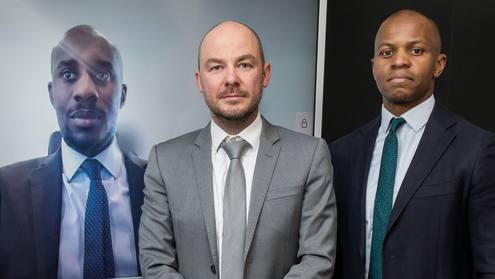Banks like to play to their strengths, and when proposing financing solutions for clients they may lean towards products with which they know they excel. The credit finance team at Goldman Sachs prides itself on being product-agnostic, insisting that finding the best solution for the client is what really matters.
Christina Minnis, Goldman Sachs’s head of global credit finance and head of global acquisition finance, says it is this that distinguishes the team from its competitors.
“We truly are product-agnostic and approach each transaction with our clients’ desired outcome in mind,” she says. Some clients, she adds, require a leveraged finance option, others a structured solution, and some need a blend of both.
“Where we excel is when we innovate and create solutions for our clients providing access to new investors and attractive, flexible sources of capital,” Ms Minnis says.
So what exactly does that mean? Jeff Warren, a managing director on the leveraged finance syndicate desk, agrees that competition between leveraged finance and structured finance is not unusual at investment banks. But at Goldman Sachs, he explains, the two businesses are non-territorial regarding each other.
“Our approach is to provide the best solution for our clients,” emphasises Mr Warren, who heads the technology, media, telecom and consumer/retail sectors on the desk. “We don’t care which way the business goes. We’re unbiased. We want to grow the whole pie.”
A unique deal
A practical example of how different product teams can work together on a challenge was provided by a $200m transaction earlier this year for Globalstar.
In September 2022, the telecom infrastructure provider announced a partnership agreement with Apple. It committed to providing satellite capacity for off-the-grid connectivity services for the iPhone 14, which offers users an “emergency SOS via satellite” service.
As part of the Apple deal, Globalstar will acquire 17 new satellites and replenish its existing constellation by 2025. It promised to raise debt capital to fund the acquisitions and to refinance its existing secured debt.
A year ago, the company approached Goldman Sachs to say it had signed the deal, which required considerable investment, but that it was not quite sure how to finance it.
We don’t care which way the business goes. We’re unbiased. We want to grow the whole pie
“This was a very non-traditional situation,” says Jordan McCallum, a Goldman Sachs managing director, head of the Americas restructuring group within leveraged finance and part of the alternative capital solutions team. “It wasn’t strictly project finance, and it wasn’t perfect structured finance or leveraged finance. Did it call for straight equity, maybe? The answer was in the middle.”
Meetings drew in representatives of all these business lines, including the equity team, to discuss how to run the process and what would be the best form of financing. “We initially took a quasi-project finance path, and then we considered a structured equity solution,” Mr McCallum says. “Finally, we found an investor who was willing to provide a private credit solution.”
Globalstar sold $200m of 13% senior notes, due in 2029, to Värde Partners, a large US alternative investor. Goldman Sachs was sole placement agent. “We all collaborated and worked around the floor,” Mr McCallum reports. “Different people were called in as the deal progressed, but we were all in the boat rowing in the same direction.”
Industrial property
Flexibility comes in different guises. One area of growing activity for the bank has been in helping various sponsors to monetise their industrial property portfolios, particularly those with high-quality tenants.
There is no higher-quality tenant than Amazon, and Goldman Sachs was sole lender and bookrunner on a $1.185bn loan secured on a warehouse/distribution centre portfolio entirely leased to the online retailer.
The borrower was Preylock Holdings. Preylock is a property acquisition and management company with a fund that invests in long-term leased assets with investment grade tenants, with a focus on Amazon.
Siddharth Shrivastava, head of large loan originations in the real estate financing group, says that for such borrowers, solutions may typically lie in the commercial mortgage-backed securities (CMBS) or asset-backed securities (ABS) markets.
“For Preylock, we worked on both types of solution over the past two years,” Mr Shrivastava says. “We were ready to go in the first quarter of 2022, but then came the invasion of Ukraine and considerable widening of the market.”
The deal was put to one side. At the outset, two years ago, ABS had seemed the more attractive option. Some Amazon-tenanted logistics portfolios had recently been financed in the ABS markets very efficiently. Then Ukraine made both options unattractive.
For the next year and a half, the ABS and CMBS teams maintained regular dialogue with the client to decide which way to go, before deciding this summer that the deal would be very well-received in the CMBS markets. “The rationale was the lack of supply in the CMBS market this year, coupled with the strength of the portfolio itself,” Mr Shrivastava explains.
In August, Goldman Sachs priced a three-year fixed rate $1.035bn first mortgage commercial real estate loan, secured by 12 properties, all leased to Amazon. The mortgage loan was credit enhanced with $150m of subordinated mezzanine debt.
Oversubscription was achieved across all bond classes, showing investor demand for short-duration, top-tier credit paper, the bank says. “This was the tightest CMBS print since February 2022,” Mr Shrivastava adds.
ABS bounces back
That does not mean that ABS has ceased to evolve. As interest rates have gone up, companies that have traditionally depended on borrowing to finance capital expenditure have found themselves in an awkward place. One example is non-investment grade telecoms operators, under pressure to roll out faster fibre-based internet services, for which they need copious amounts of capital.
To help them raise the capital, fibre-to-the-home infrastructure is now being used as an asset class for securitisations. “The cashflows look more like royalties than month-to-month contracts,” says Kelly Mellecker, a senior vice-president in structured finance. “We worked with the rating agencies to develop new criteria for the industry.”
The cashflows look more like royalties than month-to-month contracts.
MetroNet, North America’s largest privately-owned pure-play fibre provider, set the ball rolling with a $1.2bn ABS deal in October 2022. Goldman Sachs was a structuring adviser on the deal, which used operational revenues and the security interest in the infrastructure itself as collateral.
In March this year, MetroNet returned with a similarly structured $690m follow-up securitisation, with Goldman Sachs as co-structuring adviser and co-lead bookrunner. In April, the bank was sole placement agent on a $239m ABS deal for fast internet provider Ting, also secured on revenues and fibre infrastructure.
More recently, Goldman Sachs was lead left bookrunner on the first fibre securitisation from a US public company. This was Frontier Communications, the largest US pure-play fibre provider. Goldman Sachs has a history with Frontier. When the latter filed for bankruptcy in 2020, the bank put in place the first-ever debtor in possession-to-exit bond to help it raise money.
In August, Frontier sold $1.6bn of term notes secured by certain fibre assets and associated customer contracts in the Dallas area. The original target of $1bn was upsized after investor education uncovered different pockets of demand, including ABS and high-yield specialists, inside large institutions.
“The three-class structure, including an A-rated senior tranche, covered different points in the capital structure and allowed us to bring in most insurance companies,” says Katrina Niehaus, head of the bank’s corporate structured finance business.
Ms Niehaus adds that the structured finance market in general feels “pretty good” right now. “It’s not the go-go of 2021, but it’s a constructive market,” she says. “We are working with some large issuers for the first time, and can get the business done relatively quickly and efficiently.”
Leveraged finance takes comfort from the fact that the bank has just cut its estimate of the risk of US recession in 2024 from 20% to 15%. “With a lower risk of recession, companies are more willing to deploy capital,” Mr Warren observes. “Investors are very keen to deploy capital so, with more rational expectations around price, that should facilitate a more constructive financial environment.”
There will be more communications securitisations to come after the Frontier deal, according to Mr McCallum. “We are looking at how we can extend the technology to other industries and asset types,” he says. “We are also looking at the artificial intelligence space, which is very much in the middle ground of structured finance and leveraged finance.”







